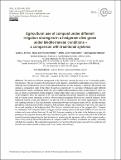Por favor, use este identificador para citar o enlazar a este item:
http://hdl.handle.net/10261/331061COMPARTIR / EXPORTAR:
 SHARE SHARE
 CORE
BASE CORE
BASE
|
|
| Visualizar otros formatos: MARC | Dublin Core | RDF | ORE | MODS | METS | DIDL | DATACITE | |

| Título: | Agricultural use of compost under different irrigation strategies in a hedgerow olive grove under Mediterranean conditions |
Autor: | Lozano de Sosa, Laura CSIC ORCID; Martín Palomo, Mª José; Castro-Valdecantos, Pedro; Madejón, Engracia CSIC ORCID | Fecha de publicación: | 19-jun-2023 | Editor: | Copernicus Publications | Citación: | Soil 9(1): 325-338 (2023) | Resumen: | Soil and water-efficient management are key factors in ensuring the olive sector's sustainable production practices. The use of compost based on olive waste (alperujo) as fertilizer could enhance ecosystem services while the need to transition to a zero-waste approach based on a circular economy is achieved. The present work includes a comparative study of the effect of alperujo compost (AC) vs. inorganic fertilization under different management systems: a traditional adult olive grove under rainfed conditions and a young hedgerow olive system, in which a factorial test of tree irrigation regimes (full, deficit and no irrigation) is implemented as well. At the hedgerow plots, the addition of AC and soil sampling time greatly impacted soil chemical parameters and, to a lesser extent, enzymatic activities, whereas irrigation regimes did not exert a marked influence. In the traditional rainfed system, the addition of AC proved to be an efficient tool for carbon sequestration. The first soil sampling revealed a clear stoichiometric relationship between soil organic matter (SOM) and the nitrogen, phosphorus and potassium (NPK) contents in both systems, whereas the correlations were weak and scarce in the second sampling at the hedgerow plots. This fact was related to the decay of the compost effect. Compost in combination with irrigation tended to trigger a certain priming effect on the native SOM with time since the carbon stocks were reduced between 6 % and 38 % from one sampling to the other in the hedgerow system, depending on the irrigation intensity. However, the deficit irrigation caused a less intense reduction of the SOM and essential nutrients representing the best alternative to maximizing the agronomic effects of the compost under a water-saving strategy. Recurrent application of compost would be necessary to maintain soil quality, especially with high tree densities. The combined management of AC and the deficit irrigation proved to be an efficient tool toward a zero-waste circular economy and a water conservation strategy. | Descripción: | 14 páginas.- 5 figuras.- 4 tablas.- referencias.- The supplement related to this article is available online at: https://doi.org/10.5194/soil-9-325-2023-supplement. | Versión del editor: | http://dx.doi.org/10.5194/soil-9-325-2023 | URI: | http://hdl.handle.net/10261/331061 | DOI: | 10.5194/soil-9-325-2023 | ISSN: | 2199-3971 2199-398X |
| Aparece en las colecciones: | (IRNAS) Artículos |
Ficheros en este ítem:
| Fichero | Descripción | Tamaño | Formato | |
|---|---|---|---|---|
| soil-9-325-2023.pdf | 4,09 MB | Adobe PDF |  Visualizar/Abrir |
CORE Recommender
Page view(s)
80
checked on 29-abr-2024
Download(s)
17
checked on 29-abr-2024
Google ScholarTM
Check
Altmetric
Altmetric
Este item está licenciado bajo una Licencia Creative Commons

